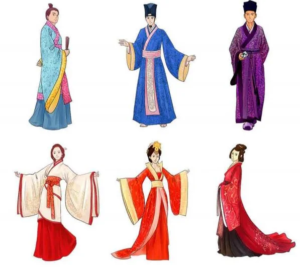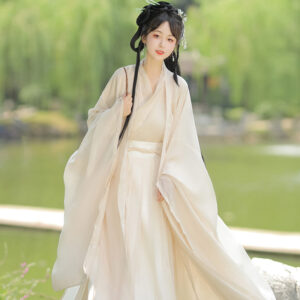

Foot binding had a profound impact on Qing Dynasty Hanfu styles, influencing both the aesthetics and functionality of women’s clothing. Here’s how this practice shaped Hanfu during the period:
1. Symbol of Femininity and Status
- Cultural Significance: Foot binding was deeply embedded in the societal values of the time, symbolizing beauty, femininity, and social status. Women with bound feet were often perceived as more desirable and refined, which influenced the design of Hanfu to accentuate these ideals.
- Lotus Shoes: The distinctive footwear associated with foot binding, known as lotus shoes, became an integral part of the outfit. Hanfu styles adapted to highlight these shoes, often featuring longer skirts that flowed gracefully over them.
2. Design Modifications
- Skirt Length: To accommodate bound feet and emphasize their smallness, Hanfu skirts were designed to be longer and more flowing. This not only concealed the feet but also added an air of elegance to the overall silhouette.
- Sleeve Styles: The sleeves of Hanfu also evolved to be longer and wider, creating a more delicate appearance that complemented the aesthetic associated with foot binding. The flowing nature of these sleeves contributed to a graceful image.
3. Aesthetic Enhancements
- Emphasis on Patterns: Designers incorporated motifs that symbolized bound feet into Hanfu patterns, such as lotus flowers. These designs drew parallels between the beauty of the lotus and the idealized qualities of small feet.
- Color Choices: The colors used in Hanfu were often chosen to complement the delicate nature of bound feet, with softer hues enhancing the overall feminine aesthetic.
4. Social Differentiation
- Class Distinctions: Foot binding became a marker of social class, particularly among Han Chinese women. The prevalence of bound feet among upper classes reinforced their identity and status, leading to distinct styles in Hanfu that reflected these social hierarchies.
- Ethnic Identity: The practice also served as a cultural differentiator between the ruling Manchu elite, who typically did not bind their feet, and the Han Chinese populace. This distinction influenced how Hanfu was styled and perceived within different social contexts.
Summary Table: Impact of Foot Binding on Qing Dynasty Hanfu
| Aspect | Influence |
|---|---|
| Symbolism | Represented femininity and social status; influenced perceptions of beauty |
| Skirt Length | Longer skirts designed to flow over lotus shoes; emphasized elegance |
| Sleeve Styles | Longer and wider sleeves created a delicate appearance |
| Aesthetic Enhancements | Incorporation of motifs like lotus flowers; color choices that complemented bound feet |
| Social Differentiation | Marked class distinctions; reinforced identity among upper-class women |
| Ethnic Identity | Differentiated between Manchu and Han Chinese styles; influenced perceptions within society |
Conclusion
Foot binding significantly shaped Qing Dynasty Hanfu styles by intertwining cultural ideals with fashion design. The adaptations made in clothing not only reflected societal values but also reinforced social hierarchies and ethnic identities during this complex period in Chinese history.
Share this post
Facebook
Twitter
LinkedIn
Pinterest
Recent Posts


What were the key features of Hanfu during the Tang Dynasty?
October 24, 2024

How did Hanfu styles vary during different Chinese dynasties?
October 24, 2024

What accessories are typically worn with Hanfu?
October 24, 2024

How do you choose the right Hanfu for different seasons?
October 24, 2024

Newsletter
Subscribe for our monthly newsletter to stay updated
Popular Categories
Related Post
Sed aliquam, tortor et sodales malesuada, lorem leo luctus tellus, quis interdum eros nibh in nunc. Cras dignissim malesuada, lorem leo luctus

What are the winter hanfu called?
October 24, 2024

What were the key features of Hanfu during the Tang Dynasty?
October 24, 2024

How did Hanfu styles vary during different Chinese dynasties?
October 24, 2024

What accessories are typically worn with Hanfu?
October 24, 2024

